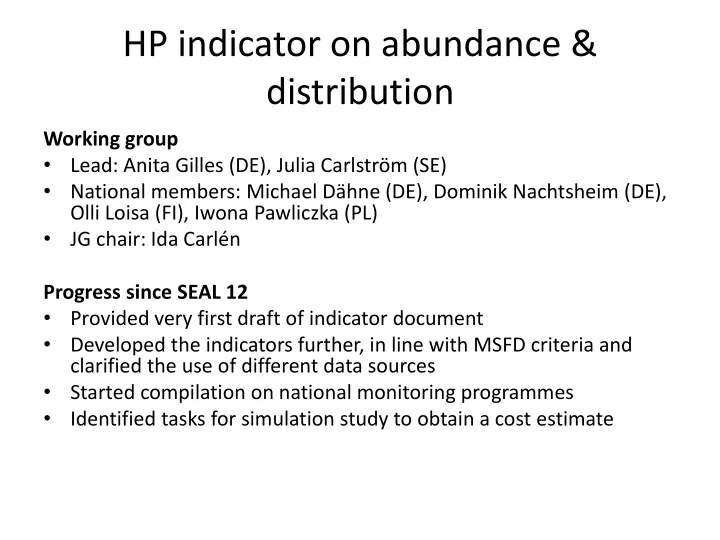

HP indicator on abundance & distribution Working group • Lead: Anita Gilles (DE), Julia Carlström (SE) • National members: Michael Dähne (DE), Dominik Nachtsheim (DE), Olli Loisa (FI), Iwona Pawliczka (PL) • JG chair: Ida Carlén Progress since SEAL 12 • Provided very first draft of indicator document • Developed the indicators further, in line with MSFD criteria and clarified the use of different data sources • Started compilation on national monitoring programmes • Identified tasks for simulation study to obtain a cost estimate
Primary MSFD criteria for HP • D1C2: The population abundance of the species is not adversely affected due to anthropogenic pressures, such that its long- term viability is ensured. • D1C4: The species distributional range and, where relevant, pattern is in line with prevailing physiographic, geographic and climatic conditions.
Two types of main datasets Large-scale surveys Key site monitoring • SCANS, MiniSCANS, • Primarily national SAMBAH monitoring programmes • Every 6 or ~12 yrs • Frequent or continuous • Visual or PAM • Visual or PAM Also available data: opportunistic sightings (live and dead), Danish telemetry data. Not yet considered.
What large-scale surveys provide • Estimate of absolute abundance • (Distribution range within survey area, requires a definition of range) • Large-scale distribution pattern • 1 datapoint/ 6 or 12 yrs takes very long time to detect trends • Coarse spatial resolution • On population level
What key site monitoring provide • Core key sites (high-density): trend in population abundance, assuming no change in distribution • Strategic key sites (high and medium density): trend in local density more fine-scale changes in local distribution patterns • Frequent or continuous data trends can be detected much quicker • Spatially representative of monitored sites • For key sites only, but also give early warning for population level assuming representativeness
What is a strategic key site? A site where a change in density is expected to occur when: • The population abundance increases or decreases • The population distributional pattern changes I.e. sites capturing for example: • A future increase in HP abundance in the Baltic Proper • A distributional shift such as observed in the North Sea
Current national monitoring • Visual aerial surveys and PAM • Frequency varies, e.g. 1/yr, 2 continuous yrs/6 yrs, continuously • Future funding often uncertain • Not yet compiled detailed methodological information
Proposed HP indicators on abundance & distribution Indicator Large-scale surveys Key site monitoring Absolute abundance Absolute estimate of population abundance Trend in abundance Trend in absolute Trend in (relative) abundance density in core key sites (Distributional range) (Range within surveyed area) Distributional pattern Large-scale pattern Trend in (relative) density in strategic key sites
Simulation study • When can we detect a trend in absolute abundance based on SAMBAH surveys only, and if we increase the survey frequency? • What is the optimal design for key site monitoring? • What is the suitable time unit for detecting trends in key site monitoring? • When can we detect trends in key site densities? o In core key sites: trend in population abundance o In strategic key sites: change in distribution pattern
Next steps • Definition of Reference Levels • Definition of key sites • Identify strategic key sites for distributional monitoring • Simulation study • Continue working on the indicator document, need clarification on full division or subdivision of the indicators (# of documents?) • Develop monitoring guidelines for harmonised key site monitoring, based on information from national monitoring programmes
Recommend
More recommend